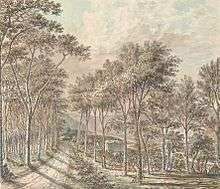Hengwrt Chaucer
The Hengwrt Chaucer manuscript is an early-15th-century manuscript of the Canterbury Tales, held in the National Library of Wales, in Aberystwyth. It is an important source for Chaucer's text, and was possibly written by someone with access to original authorial holograph, now lost.
The Hengwrt Chaucer is part of a collection called the Peniarth Manuscripts which is included by UNESCO in its UK Memory of the World Register, a list of documentary heritage which holds cultural significance specific to the UK.[1] It is catalogued as MS Peniarth 392D.
History of the manuscript


The Hengwrt Chaucer has been in Wales for at least 400 years. This was one of the collection of manuscripts amassed at the mansion of Hengwrt, near Dolgellau, Gwynedd, by Welsh antiquary Robert Vaughan (c.1592–1667); the collection later passed to the newly established National Library of Wales.
The Hengwrt manuscript's very early ownership is unknown, but recent research suggests that Chaucer himself may have partly supervised the making of the manuscript, before his death in October 1400, according to the Welsh newspaper The Western Mail.[2] By the 16th century it can be identified as belonging to Fouke Dutton, a draper of Chester who died in 1558. It then seems to have passed into the ownership of the Bannester family of Chester and Caernarfon, and through them was in the possession of an Andrew Brereton by 1625; by the middle of the 17th century it had been acquired by Vaughan.[1]
Description
Peniarth MS 392 D contains 250 folios with a page size of around 29 x 20.5 centimetres. It is written on heavily stained and rather damaged parchment. Vermin have eaten around nine centimeters from the outer corners of the leaves. It is less complete than the Ellesmere manuscript, and the tales are in an order that is unique to itself.[3] The main textual hand has been identified with one found in several other manuscripts of the period (see below); there are a number of other hands in the manuscript, including one of a person who attempted to fill in several gaps in the text. This has been tentatively identified as the hand of the poet Thomas Hoccleve.[4]
There is some illumination in blue, gold and pink, used on the border and on initial letters at the opening of individual tales and prologues, but the manuscript contains no illustrations.[5]
Scribe and relationship to other manuscripts
The lavishly illustrated Ellesmere manuscript, which for many years, following the examples of the editor Frederick Furnivall and W. W. Skeat, was used as the base text for more modern editions of the Canterbury Tales, is now thought to have been written by the same scribe, though the arrangement of the individual tales in the two manuscripts varies widely. Linne Mooney, a literary scholar at the University of York, has claimed to have identified this scribe as Adam Pinkhurst, the same Adam to whom Chaucer wrote a poem, admonishing him for his occasionally inaccurate copying skills.[6]
Since the work of John M. Manly and Edith Rickert in compiling their Text of the Canterbury Tales (1940), the Hengwrt manuscript has had a much higher degree of prominence in attempts to reconstruct Chaucer's text, displacing the previously prominent Ellesmere and Harley MS. 7334. Recent scholarship has shown that the variant spellings given in the Hengwrt manuscript likely reflect Chaucer's own spelling practices in his East Midlands / London dialect of Middle English, while the Ellesmere text shows evidence of a later attempt to regularise spelling; Hengwrt is therefore probably very close to the original authorial holograph.[7]
Following the terminology developed by Manly and Rickert, the manuscript is conventionally referred to as Hg in most editions giving variant readings.[8]
See also
References
- 1 2 "The Hengwrt Chaucer". www.llgc.org.uk. Retrieved 2017-08-09.
- ↑ "Original Chaucer Masterpiece on Show for the World to See." Western Mail (Cardiff, Wales). 2014. Accessed via HighBeam Research August 9, 2017 (subscription required). https://www.highbeam.com/doc/1G1-365966888.html
- ↑ Goldie, Matthew Boyd (Apr 15, 2008). Middle English Literature: A Historical Sourcebook. John Wiley & Sons. p. 139. ISBN 0470752122. Retrieved 11 October 2017.
- ↑ Mosser, D. W.The Hengwrt Manuscript Description Archived 2008-07-25 at the Wayback Machine., Canterbury Tales Project
- ↑ Goldie, Matthew Boyd (Apr 15, 2008). Middle English Literature: A Historical Sourcebook. John Wiley & Sons. p. 139. ISBN 0470752122. Retrieved 11 October 2017.
- ↑ Nagle, M. Finding Adam, Umaine Today, Oct/Nov 2004
- ↑ Horobin, S. The Language of the Hengwrt Chaucer Archived 2008-07-25 at the Wayback Machine., Canterbury Tales Project
- ↑ See Manly and Rickert, The Text of the Canterbury Tales, I: Descriptions of the Manuscripts, 1940, p.266
External links
- Canterbury Tales Project digital facsimile of the whole Hengwrt Chaucer manuscript, edited by Estelle Stubbs
- Specimen pages